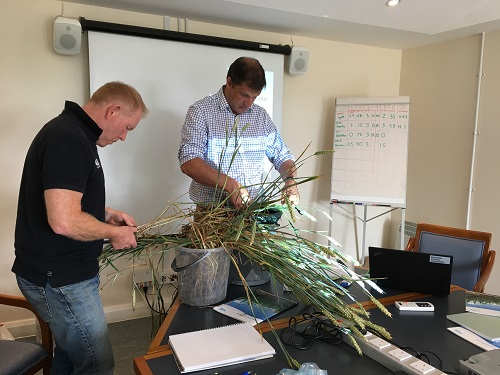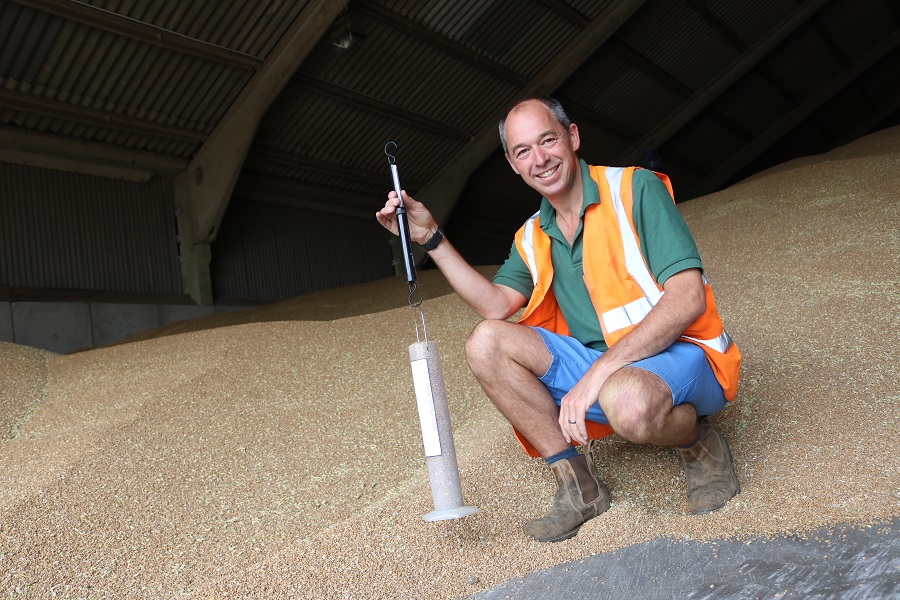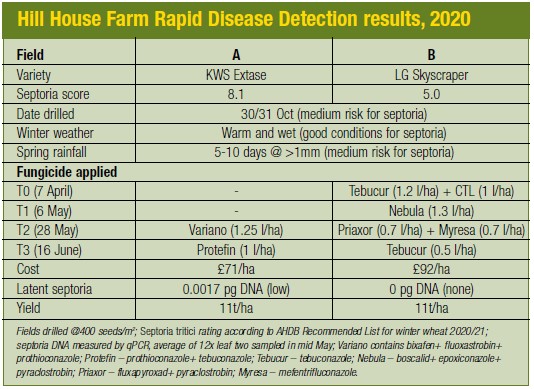In an extraordinary season, the use of new technology allowed one Norfolk grower to better inform his T2 fungicide decision and achieve impressive results despite missing a main fungicide timing. CPM visits to find out how.
It’s important to see for yourself how novel ideas perform.
By Tom Allen-Stevens
Ask John Barrett about the current size of the arable enterprise he runs, and he hesitates in his reply. “The way we farm is not about the area over which we operate but how we farm that area,” he says.
The proof of this appears to be heading out of the barn – John takes a cylinder of his KWS Extase wheat to weigh from the heap what’s being loaded into the lorry and finds the specific weight is in excess of 80kg/hl from a field that yielded 11t/ha. But it received no fungicide at either the T0 or T1 timing, with a flag-leaf application of 1.25 l/ha Variano Xpro, followed by an azole application at T3. So was it luck or good judgement and can technology be used to indicate the real impact when fungicide applications don’t go as planned?
Based at Hill House Farm on the Ditchingham Estate in Norfolk, John is manager of seven farms run by Sentry Norfolk and a Sentry director. Since arriving in 2001, the business has expanded considerably with seed potatoes recently joining the rotation, based around winter wheat, winter barley and oilseed rape. Peas, spring barley and linseed are also grown on the predominantly heavy clay soil with some light sandy gravel.

The Sentry managers meet once before harvest to analyse grab samples for grain sites, spikelet number and other qualities to get a yield prediction
“In the past we may have been looking to expand the business, but now we’re focused on new opportunities. So we’re experimenting with different crops, and a series of on-farm trials to see how new technologies fit in with our system – it’s important to see for yourself how novel ideas perform,” notes John.
He’s bringing the same thinking to his fungicide strategy. “We’d never compromise on the T2 spray – all the evidence points to that being the one that brings the greatest return. The key questions are how to keep the crop free of disease earlier in the season and whether we can tailor the T2 accordingly. If we can reduce the amount we spray, that can represent a considerable saving across the cropped area.
“But it would be a false economy if we then end up with wheat full of rust and septoria. That challenge has become much greater with the loss of chlorothalonil (CTL) – the protectant fungicides are now more expensive, while the curative ability of the chemistry is rapidly waning.”
For many years, John has been part of Bayer’s Xpro club, taking part in split-field trials to put new fungicide technology through its paces. More recently, there’s been a group of Sentry managers who have come together to compare and benchmark results they’ve achieved through their involvement with the Yield Enhancement Network (YEN). The group’s co-ordinated by Bayer, and it’s through this relationship that John has been trying out Bayer’s new Rapid Disease Detection technology.
“I’d be lying if I said there wasn’t a competitive element within the YEN group, although the benefit we really get out of it is the attention to detail this brings to how you grow a crop,” says John.
The group meets twice a year, once just before harvest, which is a chance to analyse grab samples, and again in Nov or Dec, when they take a close look at the YEN reports. A grab sample is a whole wheat plant, taken close to harvest, that’s assessed for grain sites, spikelet number and various other qualities and this results in a yield prediction as well as an assessment of disease and resilience. The meeting is a good opportunity for the growers to discuss how they got on, notes John.
“We met through web conference this year, which was great in terms of time saved not having to trek halfway across the country. But what you miss are the subtle remarks and observations we all share when we get together that really turn out to be one of the most valuable aspects.”
Latent disease testing is an aspect that has interested John for a while. “It’s a good decision support tool – it’s well established that you have to apply a fungicide well before you see visible symptoms of disease. But we need good evidence to justify the decision to spray,” he notes.
In previous years, however, the results of the test hadn’t come back until after the relevant sprays had been applied. “That’s why I was interested in trying Bayer’s new Rapid Disease Detection. I wanted to see how we could tailor the all-important T2 spray to the actual level of disease in the leaf.”
A keen advocate of on-farm trials, John tried the service on two fields of winter wheat, both drilled at the end of Oct. One was his Extase – a new variety introduction for the farm with a high septoria rating – while the other was drilled with LG Skyscraper, which has a relatively low septoria score.
“It was always the intention to grow the Extase without any applications of CTL, and specifically no T0 spray. But the weather changed around the T1 timing, and the crop moved too quickly through the growth stages, beyond the appropriate timing. The Skyscraper received the full T0 and T1 fungicide programmes, however,” reports John.
The upper leaves of both crops appeared completely free of disease when the leaf samples were taken and he got the results back about five days later, in time for the T2 spray. “The amount of septoria in leaf two of the Extase was incredibly low, considering it hadn’t received any fungicide, while the Skyscraper was clean, unsurprisingly. Not only did we have relatively low levels of septoria in both crops, the results were benchmarked against other years, showing it to be a low disease year, and both crops were given a standard fungicide dose.”
So what did the test tell him? “Without the results, we would probably have raised the rate of the T2 spray on the Extase, and I’m not sure that would have given us a financial return. In hindsight, given the low disease levels, we could actually have cut back on the T2, although the test showed leaf two of the Extase was still infected so perhaps that’s a gamble you’d only take if your result came back as zero.”
For 2021, the plan is to roll out Extase as a mainstay variety. KWS Parkin is being introduced – although not particularly strong on septoria, it’s short, stiff and early to mature, notes John – while he’s also trying KWS Cranium that has OWBM resistance.
“These are good feed varieties and we’re a long way from a mill,” he explains. “For us at T0, rust tends to be a bigger concern than septoria. Then we’ll see what disease pressure develops next spring – we can’t expect to have the same luck we had this year, but we now have the confidence we can put Extase in outlying blocks, for example.
“The plan would be to apply the appropriate T1 spray for the season, but if the weather turns against us again, we know we can fall back on Extase’s disease ratings, which will allow us some more flexibility. We can then do some latent septoria testing to find out whether we need to beef up the T2 or perhaps even cut it back. Our experience this year has given us the confidence to use the test to inform our decisions and looking to the future, I’m convinced it’ll be important to have the justification.”
Rapid results have powerful potential
Drilling date, variety and weather may help towards indicating the potential for septoria to develop in your wheat crop, but there are so many other variables that it’s very difficult to make a prediction with any degree of accuracy, notes Bayer combinable crops fungicide campaign manager Rosalind Martin.
“We should be working to make smarter fungicide choices, however – that means reliable ways to inform decisions and justify applications made,” she says.
The difficulty with Septoria tritici is that symptoms aren’t visible until 2-3 weeks after infection, and that’s some time after even curative fungicides cease to be effective. “This prompted Bayer seven years ago to explore how quantitative polymerase chain reaction (qPCR) technology can be used – this lab-based approach determines the quantity of pathogen DNA in a given leaf sample.”
It quickly became a reliable way to tell whether a protective fungicide could be used – where the fungal pathogen hadn’t yet developed hyphae – or if smarter, curative technology was needed. A useful research tool, consistent results over four years showed how varietal resistance could be harnessed to manage disease. But until 2019 latent testing was still a retrospective tool as it took too long to process results.
“We wanted a test that could inform in-season decisions, so looked for a lab that could turn around results in less than three days. We’re now working with NIAB who provide the Rapid Disease Detection service. In 2020 we tested over 12,000 leaves, which included working with more than 40 growers who have used the test to carry out their own on-farm comparisons,” notes Rosalind.
What they got back was the actual amount of septoria DNA in picogrammes, an indication as to whether it was low, medium or high, with these benchmarked against other results within the season and from previous years. “The test gives growers an extra layer of information to combine with other factors that they know about their crop. It’ll inform decisions on what rate of fungicide, such as Ascra Xpro (bixafen+ fluopyram+ prothioconazole) to use or whether to include a multisite,” she points out.
“Variety, drilling date and weather, as well as early season fungicide use will all contribute to disease development. The low level of septoria in John’s Extase, for example, indicate its strong resistance rating. But missing the T0 and T1 fungicide allowed disease to develop while Skyscraper’s leaf 2s were clean of septoria on a full spray programme.”
A similar trial conducted by Essex grower James Nott pitched Oct-drilled Extase against Dec-drilled KWS Kerrin. While both crops had a low level of disease overall, there was 100 times as much septoria DNA in the Kerrin compared with the Extase.
Seven years of work and an impressive dataset gleaned from sites and varieties across the UK build into what Rosalind believes could be a new way to visualise fungicide trials. “We’ve used the test on our demo sites across the UK which gives a national view of septoria levels, as well as a snapshot of how the disease is developing in all the major varieties.”
Making sense of this wealth of information is probably beyond the human brain, however, which is where Bayer FieldView comes in. This is the company’s new digital farming platform that’s currently being trialled by around 50 farmers across the UK. It uses powerful algorithms to process weather data along with site-specific information to help growers make better informed decisions.
“Every farm is different, and no algorithm will deliver the answer on its own. But FieldView, ground-truthed by Rapid Disease Detection and enhanced through groups of growers working together, sharing data and collaborating – that could become a very powerful and robust way to make precise, informed choices in years to come,” Rosalind concludes.
Partners in performance
Partners in Performance is the result of a long-standing collaboration between Bayer and a group of progressive growers.
It started in 2011 with the launch of Aviator Xpro when growers were invited to trial Aviator on their farm. In these split-field trials Bayer took a back seat with the only demands being the field area for fungicide comparison and crop yield verified over a weighbridge or via combine yield monitor –– everything else was down to the farmer.
Over time this has developed into a club. Each year the farmers meet to discuss results, listen to guest speakers and debate winter wheat management issues.
Farming has always been a challenging business, and with Brexit those challenges have intensified. The margin between profit and breaking even is likely to become even tighter and any incremental gain will be needed for sustainable combinable crop production.
To achieve that the industry needs to work together to share the latest research and thinking, exchange ideas and experiences.
Partners in Performance aims to bring farmers and specialists together to develop solutions to improve crop performance and investment return.





